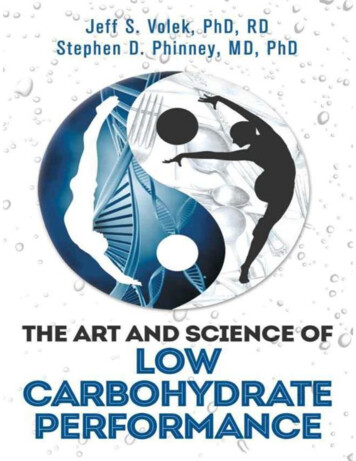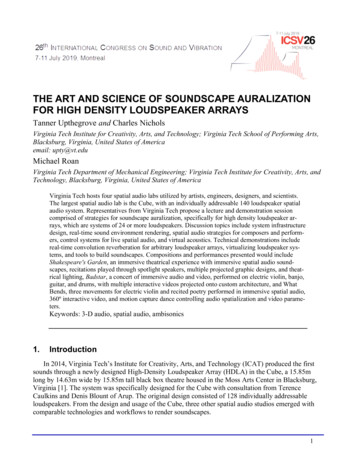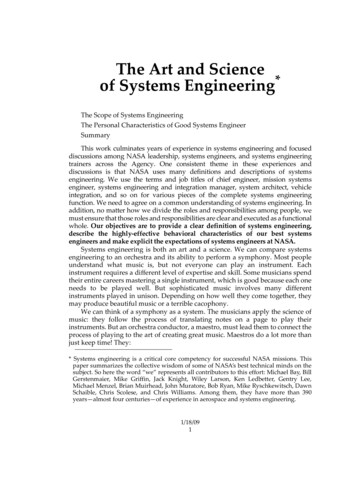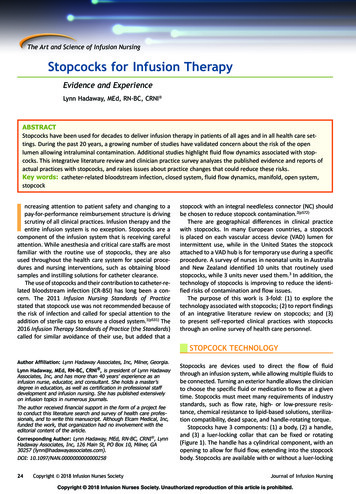
Transcription
THE ART AND SCIENCE OFLOW CARBOHYDRATEPERFORMANCEA Revolutionary Program to Extend Your Physical and Mental Performance EnvelopeJeff S. Volek, PhD, RDStephen D. Phinney, MD, PhD
Other Books by Jeff Volek and Steve PhinneyMen’s Health TNT DietJeff Volek and Adam CampbellRodale Books 2008The New Atkins for a New YouEric Westman, Jeff Volek, and Stephen PhinneyFireside/Simon & Schuster 2010The Art and Science of Low Carbohydrate LivingJeff Volek and Stephen PhinneyBeyond Obesity LLC 2011(available at www.createspace.com/3608659)Above Evil – A Science Prediction NovelStephen PhinneyBeyond Obesity LLC 2012(available at www.createspace.com/3779119)The information in this book is provided to assist the reader in making informed choices about diet and exercise. This book is neither intended as a substitutefor medical advice nor to replace professional athletic coaching. Before starting any diet, you should consult your personal physician.Copyright 2012 Beyond Obesity LLCAll rights reserved.Cover design by Brian ZimmermanIS BN: 978-0-9834907-5-3 (ePub)IS BN: 978-0-9834907-1-5 (Print)Visit us at www.artandscienceoflowcarb.comAdditional paperback copies available at www.createspace.com/3827132
QED stands for Quality, Excellence and Design. The QED seal of approval shown here verifies that thiseBook has passed a rigorous quality assurance process and will render well in most eBook readingplatforms.All eBook files created by eBook Architects are independently tested and certified with the QED seal.For more information please see:ebookarchitects.com/QED.php
ContentsAcknowledgementsSection 1: THINKING DIFFERENTChapter 1: INTRODUCTIONHumans Can FlyChapter 2: METABOLISM BASICSA Functional Look At Fuel UseChapter 3: A TECTONIC SHIFT IN THINKINGKeto-Adaptation: The Most Efficient Path To Accelerated Fat BurningChapter 4: KETO-ADAPTATIONMetabolic Benefits And Sports ImplicationsChapter 5: EXERCISE RECOVERYReturning Rapidly To Full FunctionSection 2: IMPLENTING YOUR DIET PLANChapter 6: CARBOHYDRATEWhy It Is Unnecessary And How To Restrict ItChapter 7: PROTEINNecessary, But In ModerationChapter 8: FATYour Most Important FuelChapter 9: FLUID AND MINERAL MANAGEMENTWhy Micronutrients Can Have A Macro-EffectChapter 10: PERSONALIZATIONFinding Your Ketone Zone And MoreChapter 11: SAMPLE MENUS AND RECIPESEating The Right StuffChapter 12: LOW CARB ATHLETESPersonal Observations From Athletes Pushing The EnvelopeReferencesGlossaryAbout The Authors
AcknowledgementsThe opening paragraph of our recent book “The Art and Science of Low Carbohydrate Living” discussedthe ancient Chinese curse: ‘may you live in interesting times.’ In the intervening year, we sense even moremovement towards a consensus change; whereby the clinical use of low carbohydrate diets in themanagement of insulin resistance may soon become mainstream. We are genuinely appreciative of thepositive and constructive feedback from people who have taken the time to write us. Many of you askedspecifically about exercising during a low carbohydrate diet, and several shared your personalexperience with us. Your feedback inspired us to write this book. Now we say to each other “we live inreally interesting times” because it’s looking like a consensus change on the use of low carbohydrate dietsfor athletes may come sooner than their general use in medical care.We are thankful for the support of the many people who encouraged us to address the role of lowcarbohydrate diets in sports and exercise. We appreciate the thoughtful comments on early drafts fromPeter Defty, Peter Davis, Brian Kupchak, Brittanie Volk, and Cynthia Moore. A special thanks to thoselow carbohydrate pioneer athletes who were willing to share their personal experience for this book –Tony Ricci, Andrea Hudy, John Rutherford, Bettie Smith, Doug Berlin, David Dreyfuss, and JayWortman.I (Steve Phinney) wish to thank Dr. Richard Handler who introduced me to cycling, Dr. Edward Hortonwho got me started in performance research, and Dr. Bruce Bistrian who taught me to regard nutrition as ascience. A special thanks to my co-author and friend Jeff, with whom writing is a joy; and to Doug Bibusfor his unwavering friendship and collaboration. Infinite appreciation goes to my family – to Lauren andEric who put up with my abstruse verbal meanderings during road trips up and down Interstate 5; and tomy remarkable wife Huong, without whose intellectual GPS I would be forever lost on the backroads ofdetail.I (Jeff Volek) wish to thank my supportive parents who provided me many opportunities to play andcompete in sports from a young age, Dr. Linc Gotchalk who coached me in the sport of powerlifting, andDr. William Kraemer who taught me a deep appreciation for the complexity of exercise science. Aspecial thanks to my co-author Steve, who has inspired and enriched my life beyond what I can express inwords. Above all I want to thank my loving and patient wife, Ana and my two boys, who supported me inspite of the significant time this book project took away from them.
Section 1
THINKING DIFFERENT
Chapter 1INTRODUCTIONHumans Can Fly“Perfection is not attainable. But if we chase perfection, we can catch excellence.”-Vince LombardiIf you are completely content with your body, health, and performance on a high carbohydrate diet there isprobably no reason to consider a low carbohydrate diet. If it isn’t broke, don’t fix it. But if you have hit aplateau, are in a rut, suffer from overtraining, have trouble recovering from your workouts, want to changeyour body composition, or simply want to experiment with how your body adapts to restrictingcarbohydrate, then this book is for “You”.“You” might be an elite athlete, coach, trainer, dietitian, physician or scientist. You might be a casualfitness enthusiast or wanna-be athlete. You might be new to exercise, a week-end warrior, or a veteran ofthe gym but aren’t satisfied with your progress or feel drained. If any of these people are You then thisbook may have something valuable to offer.In our recent book, ‘The Art and Science of Low Carbohydrate Living’[1], we made a strong case for lowcarbohydrate diets as the preferred approach to managing insulin resistance (aka carbohydrateintolerance). However, on the continuum of insulin resistance, athletes as a group cluster on the side ofinsulin sensitivity. Thus most athletes do not have anywhere near the same level of carbohydrateintolerance as someone who is overweight with metabolic syndrome or diabetes.Why then would we recommend a low carbohydrate diet for athletes? After all, the current majoritygroup-think in sports nutrition holds that all athletes have an obligate need for carbohydrate. But despitehaving the best intentions, the majority view does not always represent the truth. Besides exacerbatinginsulin resistance, a high carbohydrate diet also locks a person into a dependence on carbohydrate asthe dominant fuel for exercise. And every endurance athlete knows what happens to performance whentheir carbohydrate tank (at best holding 2000 Calories) runs dry – performance goes down in flames. It’san unfortunate reality that the human body is unable to promptly switch from carbs to fat as its
predominant exercise fuel, so once the former is gone, you can’t power your performance with fat (eventhough a carbohydrate-depleted body still has tens of thousands of fat Calories on hand).The key fact underlying this book is that you can train your body to burn fat by simply changing your dietover a period of a few weeks, thereby turning blood sugar and glycogen into secondary fuels. Once youmake this transition, you can then train harder, perform longer, and recover faster. So the simple answerto why we endorse a low carbohydrate lifestyle for athletes is that this strategy has worked for us andmany people we know. More importantly, we have both conducted and published human research thatsupports this approach, adding to a growing body of literature that now points to the merits of reducingdietary carbohydrates to optimize fat metabolism. We have thus accumulated a unique knowledge basethat we want to share so you too may experience it for yourself.Do we understand that exercising without carbs is heresy? Absolutely, but think about it from thisperspective. Before December 17, 1903, about 99% of the population thought that humans could never fly.Not long after that, the proportions for and against the possibility of human flight were reversed. In the6000 years since small pockets of humanity first developed agricultural carbohydrates, most of us havecome to believe that agricultural carbohydrates are necessary for health, and particularly for sportsperformance. Is this indeed true? Or is it more akin to the world view on the day before the WrightBrothers flew? Perhaps most of us are victims of Stockholm Syndrome, having emotionally adopted thedistorted views of the agricultural paradigm that has us ensnared, if not enslaved.Among scientists, and in the general population as well, some argue that dietary carbohydrates areaddicting. Whether the human brain’s response to carbohydrate withdrawal is characteristic of a trueaddiction response remains a topic of debate. However it is true that, from a functional perspective, onceyou light your metabolic fire with carbohydrates, it is hard to ignore the incessant signals to keep feedingit more and more carbohydrates at frequent intervals.Another aspect of our cultural dependence on carbohydrates stems from the low cost and high per-acreproduction that dietary carbohydrates deliver, allowing humanity to burgeon way beyond those populationlevels supported by traditional hunting and herding cultures.What is ‘best for a population’, however, may not be best for the individual. Elite athletes are, bydefinition, about as different from the general population as you can get. By whatever combination ofinborn capabilities plus intense training and commitment, athletes transcend the population’s norms bothin physical performance and in nutrient needs. From this perspective, the correct combination of foodswhich best make and sustain athletic prowess must be considered as potentially unique rather than‘normal’.Jared Diamond, the acclaimed geographer and author, notes that with the advent of agriculture in SouthernEurope, the average height of the population decreased by six inches, and the average longevity declinedby 10 years[2]. Similar effects were observed in Native North Americans when agriculture was adopteda thousand years before Columbus discovered they were there. Holdouts against this agricultural trend,such as those nomadic cultures (e.g., Osage, Kiowa, Blackfeet, Shoshone, Assiniboine, and Lakota) thatlived almost solely on the buffalo, were 6-12 inches taller than the European settlers whose sustenancedepended on wheat and corn[3]. Interestingly, the Masai in East Africa also lived as nomadic herders ona diet of meat and milk, and they too were known for their unusual height and physical prowess.
These observations support the concept that a diet consisting mostly of fat and protein can supportremarkable growth, physical well-being and function – in essence, promoting the capabilities of theindividual over commonly assumed societal norms.But all of this information is old. Why write this booklet now? What has changed is that we (not just thetwo of us, but the greater ‘we’ encompassing many colleagues) are now wrapping up a remarkabledecade of human research on diets lower in carbohydrate and commensurately higher in fats and protein.In the last 10 years, ‘we’ have discovered that:Low carbohydrate diets are anti-inflammatory, producing less oxidative stress during exercise andmore rapid recovery between exercise sessions.Physiological adaptation to low carbohydrate living allows much greater reliance on body fat, notjust at rest but also during exercise, meaning much less dependence on muscle glycogen and lessneed to reload with carbohydrates during and after exercise.Low carbohydrate adaptation accelerates the body’s use of saturated fats for fuel, allowing a highintake of total fats (including saturates) without risk.At the practical level, effective training for both endurance and strength/power sports can be done byindividuals adapted to carbohydrate restricted diets, with desirable changes in body compositionand power-to-weight ratios.A low carbohydrate lifestyle is not necessarily ideal for every athlete, but it is clearly desirable for some.To make an informed choice, however, every individual needs a basic understanding of how lowcarbohydrate diets function to support human physiology. Much of this information has been covered inour recently published book “The Art and Science of Low Carbohydrate Living”. In addition, however,both the athlete and coach/trainer need to understand how to integrate this diet with training to yieldsuperior performance, and how one can then sustain this functional peak to span a higher volume oftraining and competition.The purpose of this booklet is to provide this additional information to satisfy the specific needs ofindividual athletes, whether your intent is competition or recreation. This goal is efficiently met byproviding you with 12 concise chapters with a minimum of theory and a maximum of practical direction.After considering this information and making appropriate changes in your diet, perhaps you too willexperience a paradigm shift in how you feel and function, and maybe ‘catch excellence’. Humans can fly!Procedural Note: We use a lot of acronyms in this book. While they are all defined when used initially,they tend to become an ‘alphabet salad’ in later chapters. To alleviate that problem, we have provided aglossary of terms at the end of the print version of the book.
Chapter 2METABOLISM BASICSA Functional Look At Fuel Use“We cannot solve problems by using the same kind of thinking we used when we created them.”-Albert EinsteinSnap ShotBody stores of fat fuel (typically 40, 000 Calories [kcal]) vastly exceed its maximum stores ofcarbohydrate fuel ( 2,000 kcal).Fueling tactics that emphasize carbohydrate-based diets and sugar-based supplements bias yourmetabolism towards carbohydrate while simultaneously inhibiting fat mobilization and utilization.This suppression of fat oxidation lasts for days after carbohydrates are consumed, not just the fewhours following their digestion when insulin levels are high.This high carbohydrate paradigm produces unreliable results, especially during prolonged exercisewhen body carbohydrate stores are exhausted.In order to sustain a high level of performance under conditions of glycogen depletion and decreasedglucose availability, cells must adapt to using fat fuels. This process is referred to as keto-adaptationwhich has the potential to improve human performance and recovery.Previously held beliefs about the magnitude of peak fat burning need to be reconsidered in thecontext of data obtained after keto-adaptation.It is accepted dogma within the science of sports nutrition that carbohydrates are essential and that theyare the preferred fuel for athletes. Indeed, over the last 45 years a great deal of progress has been made inunderstanding how to use carbohydrates to optimize the metabolic response to physical activity. Thisunderstanding in turn has driven development of nutritional approaches to prevent fatigue and improveexercise tolerance. We don’t want to play down the extraordinary work of researchers who havecontributed to this knowledge. However it is instructive to point out that ever since the observation overfour decades ago that low muscle glycogen was associated with fatigue, most of that progress has beenfocused on ways to enhance glycogen levels and carbohydrate oxidation (e.g., carbohydrate loading, useof multiple sources of sugars, etc.). Little effort has been devoted to developing methods to decrease thebody’s dependence on carbohydrate during physical activity. The result is a billion dollar sportsbeverage and supplement industry that aggressively promotes rapidly absorbed sources of carbohydratebefore, during, and after exercise. We contend that there’s a limit to what can be achieved by consumingsugary drinks and gels in hopes of delivering optimized fuel flow, and that it is time to take a serious lookat the other side of the coin.Is the research used to support high carbohydrate diets flawed or in some way misaligned with what we
know about human physiology? Not exactly – it’s more a case of willful neglect. The belief thatcarbohydrate is the ideal fuel source and that a high carbohydrate diet is optimal for all athletes are selfreinforcing concepts that have been passed down to at least a couple generations of sport scientists. Manyof the experiments conducted during that time were designed in a specific manner and data interpretedwithin a narrow mindset to support and confirm the high carbohydrate paradigm. The result is a classicexample of conformation bias – the tendency to favor information that confirms a preconception orhypothesis regardless of whether it is true.Despite the tenacity with which mainstream sports nutritionists defend the notion that a high carbohydrateintake is an obligate component of all athletes’ diets, a more accurate paradigm is that carbohydrates arean obligate part of your diet only as long as you keep consuming lots of them. If you take a few weeks tobreak this self-perpetuating cycle, however, carbs can be reduced to an optional nutrient for athletes. Toappreciate this alternative view, it is helpful to understand the metabolic basis of the human fuel supply.Fueling ExerciseAdenosine tri-phosphate (ATP) is the chemical energy that fuels body processes including musclecontraction. It’s literally the energy that causes your muscle fibers to contract and produce force. At restwe are constantly breaking down and synthesizing ATP. When you exercise vigorously, ATP demandsincrease several-fold. Since we can’t store (nor do we eat) ATP in appreciable amounts, exercise causesan immediate need to rapidly make ATP from other energy sources. The two primary fuels our bodiesdraw on to do this are carbohydrate and fat. How the body chooses the proportion of carbohydrate and fatto use for fuel is complex, but one factor that has a consistent and profound effect is the availability ofcarbohydrate. The more carbs that are available, the more carbs the body burns; while at the same timeshutting down access to its much larger fuel reserve – fat.Carbohydrate Fuel TankAs noted above, carbohydrate is often viewed as the preferred fuel for athletes. From a functionalperspective, this is curious because carbohydrates cannot be stored in large amounts in the body. Whenwe talk about storing and burning carbohydrate, the ‘common energy currency’ used by the body isglucose. Glucose can be metabolized directly to make ATP, and glucose can also be stored in modestamounts as glycogen in skeletal muscle, and to a lesser extent in liver. On average, the maximum glycogenstore you can accumulate is between 400-500 grams. And since 1 gram of carbohydrate equals 4 kcal, youmax out at about 1600-2000 kcal in your carbohydrate fuel tank. Each gram of glycogen is also storedwith a couple grams of water. If you carry more muscle mass, are well trained, and eat a highcarbohydrate diet, your glycogen stores might be increased by up to another 50% or so, but the totalamount of carbohydrate available in the body is still relatively low compared to available fat stores.Fat Fuel Tank
Fat, or more specifically fatty acids, are stored in the body as triglycerides consisting of three fatty acidslinked to a single 3-carbon glycerol. Triglycerides coalesce into fat droplets that occupy 85% ofadipose tissue cells (i.e., fat cells, aka ‘adipocytes’). Unlike our limited storage of glycogen, fat cellshave a vast capacity to store fat. Since fat contains 9 kcal per gram and is stored with minimal water, theyare an efficient storage form of energy that can be mobilized quickly when blood insulin levels are low.Even in a very lean athlete, the total amount of energy stored as fat will typically be more than 20 timesthe maximum level of carbohydrate stored in the body. Thus, whereas vigorous exercise can depleteglycogen reserves in just a few hours, when adapted to burning primarily fat, this thin athlete has enoughfat to fuel several days of exercise.During prolonged exercise when body stores of carbohydrate as glycogen are depleted, there is increasingdependence on the liver to maintain blood glucose levels. This is not just to provide the exercisingmuscles with glucose, but also to support other normal body functions, especially the central nervoussystem. Decreased carbohydrate availability, particularly for the brain, marks the central event resultingin a sharp decline in physical and mental performance (i.e., hitting the wall or bonking). The currentpractice of carbohydrate loading increases glycogen stores and is often accompanied by ingestion ofsugar-based sport drinks and gels during exercise. These carb-based fueling tactics may delay the onset ofhitting the wall, but for most athletes extending beyond marathon-duration events, they will still crash andburn despite having literally many thousand Calories worth of fuel tucked away in their fat cells. Whycan’t this surplus of fat fuel be utilized even at a time when the body desperately needs it? Simply put, itcan be accessed, but it takes a few weeks of carbohydrate restriction during which time the body becomessignificantly more efficient at burning fat, a process we call keto-adaptation (discussed in the nextchapter).Keto-adaptation allows rapid mobilization and utilization of “non-carbohydrate” lipid fuel sources. Asthe name implies, this process involves the conversion of fat to ketones in the liver, and these ketoneshelp supply the brain with energy when glucose levels fall. This affords even a very lean (10% body fat)athlete access to more than 40,000 kcal from body fat, rather than starting a prolonged event dependingprimarily on 2000 kcal of glycogen.How You Burn Body Fat: Fat Breakdown
Let’s take a closer look at how we tap into the fat energy stored in adipose tissue. A key step is removingthe fatty acid from the glycerol backbone (aka, fat breakdown or lipolysis). This is achieved by theenzyme hormone-sensitive lipase. Although many factors stimulate the activity of hormone-sensitivelipase (e.g., epinephrine, norepinephrine, growth hormone, activated thyroid hormone), fat breakdown isprincipally controlled by the single hormone that inhibits its activity. That hormone is insulin. In otherwords, insulin is the primary gate-keeper of body fat. If your insulin levels are consistently high, fat usageis effectively blocked.The primary nutrient that stimulates insulin is dietary carbohydrate. Some forms of carbohydrate stimulateinsulin more than others. Thus, consumption of insulin-stimulating carbohydrates is a surefire way toinhibit your access to the energy stored as body fat during and after exercise.Taking a closer look, the relationship between insulin levels and fat breakdown is not a straight line.Instead it’s a steep curve, which means that fat release plummets with just a modest rise in insulin such asthose stimulated by most sports beverages. Looking at it from another perspective, near the bottom on theblood insulin range, just small decreases in insulin translate into large increases in fat breakdown and fatoxidation[4]. Thus, focusing on keeping insulin low is associated with significant changes in fatmetabolism, favoring decreased storage and increased fat oxidation. In case you’re wondering, insulin’seffect on fat breakdown does not take days or even hours, its effect is virtually immediate. Ketoadaptation, however, is not immediate. Keeping insulin low is a first step in increasing fat availability,but to maximize fat burning the body requires at least a couple weeks of uninterrupted low insulin levels(i.e., 2-3 weeks of consistently restricting dietary carbohydrates).Factoid: Like many things in life, a little bit of insulin is necessary, but more isn’t necessarily better.Insulin’s effects are not limited to promoting glucose uptake and suppressing fat breakdown. Inaddition to promoting storage of fat, insulin also potently and rapidly inhibits both blood fatty acidand total body lipid oxidation as well.How You Burn Body Fat: Fat Oxidation (Burning)
Breakdown of fat (aka lipolysis) in adipose tissue and its release into the blood is only half the story.Fatty acids then need to be delivered to tissues like active muscle. Triglycerides and fatty acids are notwater soluble, so in the blood, fatty acids released from fat cells are attached to a protein called albuminand delivered to muscle. Fat is taken up into muscle cells through specific transport proteins anddelivered to ATP-generating organelles within the cell called mitochondria. Transport of fatty acids intothe mitochondria is highly regulated, and some might argue that this is the rate limiting step in oxidizingfat. The other fate for fatty acids taken up by muscle, particularly during periods of rest, is conversionback to triglyceride within the muscle cell itself where it is stored as lipid droplets for later use.Factoid: In the well-trained athlete, muscles cells can store as much energy in fat droplets as they canstore as glycogen.There you have it, the path of a fatty acid molecule from storage in fat cells to oxidation in muscle. Butwhere does dietary fat fit in? Dietary fat is absorbed from your small intestine and packaged astriglycerides into a blood-bourne particle called a chylomicron. These are acted upon by fatty acidreleasing enzymes called lipoprotein lipase that reside in the capillaries that perfuse muscle and fat cells.The fatty acids released from chylomicrons can then be taken up by nearby muscle or fat cells. Onceinside muscle cells, the food-derived fatty acids mix in with the fatty acids delivered from fat cells.Exercise Intensity and Peak Fat OxidationOne factor that impacts the proportion of fat used as fuel is exercise intensity. In athletes consumingmoderate to high carbohydrate diets, as exercise intensity increases, the proportion of energy derivedfrom carbohydrate increases and that from fat decreases. This has been interpreted to mean that there is aspecific exercise intensity where fat burning peaks, above which exercise at higher intensitiesincreasingly depends on glucose and glycogen.If you start exercising lightly and gradually increase the intensity while simultaneously measuring thecontribution of fat and carbohydrate to energy use, you will find that the peak rate of fat burning (grams offat oxidized per minute or per hour) occurs on average at about 50% of maximal oxygen consumption(VO2max) if you’re untrained and at 65% VO2max if you’re trained[5]. Exercise harder and althoughpower output increases, the contribution of fat decreases, forcing carbohydrate to become the predominantfuel source. 65% of VO2max is an intensity most endurance athletes can easily maintain for several hours.This means that if you exercise above this threshold, fat oxidation normally cannot increase to meet thegreater energy demands. In fact, as you push up close to maximal oxygen capacity, there is a rather sharpdecline in fat oxidation – not just its proportion, but in absolute grams per minute as well. This is animportant detail that requires greater inspection because this line of reasoning is often used asjustification to teach away from low carbohydrate/high-fat diets for athletes who exercise at or above65% VO2max.
Typical fat oxidation rates as a function of increasing exercise intensity.First, several well conducted studies over the last few decades have provided multiple clues as to whyfat oxidation tends to decrease and carbohydrate becomes the predominant fuel at higher exerciseintensities. It’s not a simple switch that slows down fat oxidation as exercise intensity increases but rathera coordinated set of metabolic events. This metabolic symphony can play a different tune in a ketoadapted athlete, allowing significantly higher rates of peak fat oxidation at higher exercise intensities.However the minimum time for this adaptation to occur has received little attention. Most of the work inthis area has involved athletes consuming low carbohydrate diets for less than two weeks. In contrast, wehave published studies of 4-6 weeks duration that demonstrate a progressively increased capacity tomobilize and oxidize fat[6, 7] at the 65% threshold. Thus the time allotted for adaptation has the potentialto dramatically alter the ‘typical’ relation between exercise intensity and fuel use.Second, and more importantly, there is a great deal of variability between individuals consumingmoderate to high carbohydrate diets (both trained and untrained) in their capacity to burn fat at rest andduring exercise[8]. Studies almost always highlight average responses for a group, but given suchvariability between individuals, hardly anyone responds like the group average. Thus, when dealing withindividuals, it’s more interesting to look at the tails of the distribution (i.e., the outliers at the high andlow ends of a group). For example, in a study of 300 people, peak fat oxidation ranged between 10 and 60grams of total fat burned per hour. For some people peak fat oxidation occurred at very low exerciseintensities (e.g., 25% of VO2max) whereas in others it occurred up to 77% of VO2max[9].Factoid: There are remarkable differences among individuals in both the magnitude of peak fatburning and the intensity of the exercise at which peak fat oxidation occurs.How Much Fat Can Humans Burn?An intriguing question is whether oxidizing 60 grams fat per hour (1 gram per minute, or 540 kcal of fatburned per hour) represents an abs
a diet of meat and milk, and they too were known for their unusual height and physical prowess. These observations support the concept that a diet consisting mostly of fat and protein can support remarkable growth, physical well-being and











